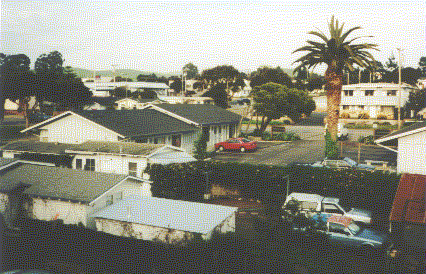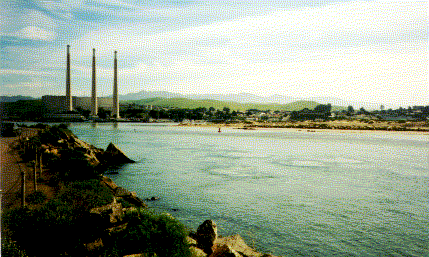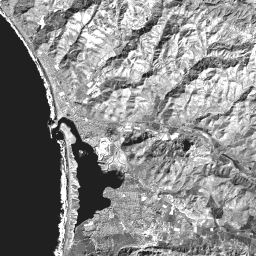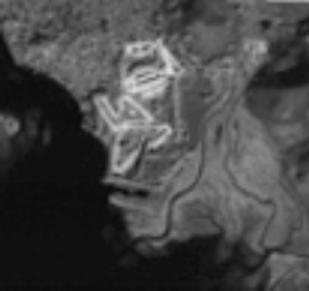
At the north end of the bay is a major electric power-generating
plant, as seen here.


At the north end of the bay is a major electric power-generating
plant, as seen here.

Taking a close look in the image, about at t, one sees a row of two dot-like light patches and then three more to the north. A glance at the aerial oblique photo will quickly reveal their identity. The stacks themselves are not clearly resolvable in the image but the large central power plant just behind them does show up as a dark-toned rectangle (it has a flat-topped roof coated with a material such as asphalt).
Several small, very bright-toned patches appear in Los Osos (as at u) and elsewhere. Some of these are borrow pits where sand and gravel deposited during earlier ocean invasions is extracted for construction and other purposes.
At this point we close our first look at the Morro Bay subscene. We will trace the expression of the labeled features described above in other bands and call attention to several additional features that stand out better in one or more of those bands. Now, rather than proceed to the next band, TM 2, we will investigate the subscene presented in band 4, which you should recall from the Introductory Section is optimal for highlighting actively growing vegetation as bright tones.
Here is TM band 4.
 |
TM Band 4 |
|---|
Your first reaction likely is that much of the land is now displayed in brighter tones and the ocean is almost uniformly dark (except where heavy silt still shows up at the mouth of the river crossing the wetlands delta). Of course, much of this brightness is associated with vegetation. Some of the dark fields (r) are now quite bright. Similar rectangles in both Morro Bay and Los Osos are city parks and meadows.

Looking again at the band 4 image above, the adjacent coastal marsh (o) is largely bright also except near the water where it darkens (more mud, less vegetation). Another area within the mountains, at v, which is somewhat darker in band 1 even though on a slope facing the sun, is uniformly bright; as a hypothesis, consider it to be a zone in which the grass cover is thicker and more active (perhaps new growth of grass from the first Fall rains).
The shadowy sides of the mountains are, in most places, less dark than in band 1 and reveal more detailed structure representing features along these slopes. This lightening is due to the presence of enough vegetation on the surfaces to contribute to this effect. Very dark shadows do persist on the north slopes of several hills east of Morro Bay town.
The beach, quite bright in band 1, is now darkened in the sandy areas to a medium tone. To its west, the breakers that are so bright in 1 now appear in a mottled, streaky pattern that probably correlates with the different parts of the waves, with some facing towards the sun (more reflectance into the TM sensor) and other parts of these transient curved surfaces facing away (darker).
Code 935, Goddard Space Flight Center, NASA
Written by: Nicholas M. Short, Sr. email: nmshort@epix.net
and
Jon Robinson email: Jon.W.Robinson.1@gsfc.nasa.gov
Webmaster: Bill Dickinson Jr. email: rstwebmaster@gsti.com
Web Production: Christiane Robinson, Terri Ho and Nannette Fekete
Updated: 1999.03.15.